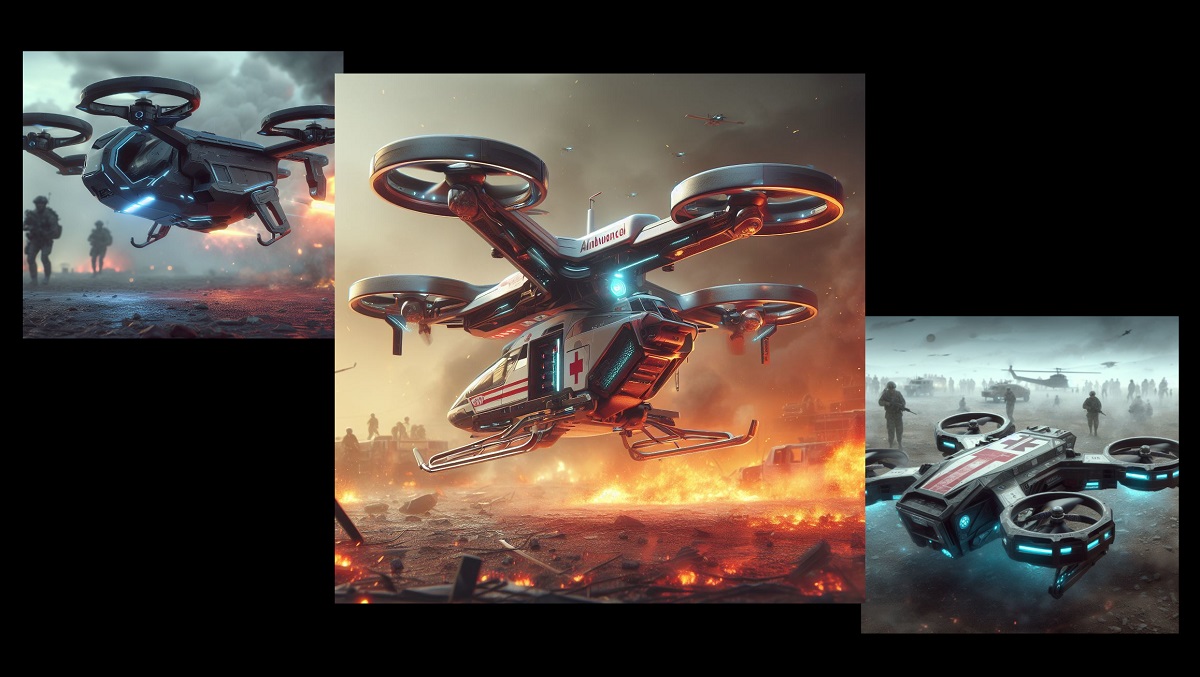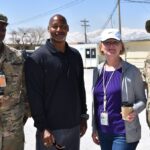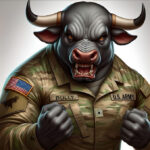
Although drones are widely used globally, the U.S. Army has not fully utilized their potential for battlefield medicine.
The development of drones is deeply entrenched in military history. In 1849, the first concept of using uncrewed aerial vehicles (UAV) or “drones” was used by Austria to attack Venice with uncrewed balloons delivering explosives. The U.S. Navy and a team of British researchers at the Ordnance College of Woolwich experimented with drones using aerial-delivered torpedoes to fight German submarines during World War One. Since these early stages of military drone usage, remotely operated aircraft have made leaps and bounds in construction, technology, and improvement. Some examples of innovative applications include: precision farming (namely, surveillance of crop growth or pest infestation); environmental services (namely, tracking of animal populations); surveillance of natural disaster sites or areas with biological hazards (namely, earthquakes, floods, and forest fires); epidemiological surveillance for the monitoring of infectious diseases (namely, COVID-19 and Ebola); and medical services that are all being explored regularly.
Although drones are widely used globally, the U.S. Army has not fully utilized their potential for battlefield medicine. Currently, medical drones are used in various medical and public health situations to supplement ground response teams and human-crewed aircraft, mainly when responders are in danger. Hospitals have begun using drones to transport laboratory samples rapidly and reliably, and humanitarian aid organizations are now using drones to bring blood products, vaccines, pharmaceuticals, medical supplies, and even organs to remote, rural areas. Moreover, medical drones have routinely been used to perform telemedicine to evaluate patients remotely using drones fitted with two-way video communication devices and sensors to monitor temperature, pulse rate, and respiratory rate.
In the remainder of this short piece, we will first explain the advantages of drones on the modern battlefield. Next, we will relate the use of drones to medicine on the battlefield by identifying several vital benefits. These include combat triage, landing ability, and evacuation support. We conclude by addressing several potential challenges that should inform the use of medical drones to support combat operations.
The use of drones on the modern battlefield provides multiple advantages. One such case is enhanced situational awareness, providing critical intelligence to commanders, thus enabling swift and informed decisions adapted to current circumstances on the battlefield. Another illustration is precision strikes that accurately identify enemy targets and lower the risk of civilian casualties. A further advantage of drones is their ability to amplify (force-multiply) conventional forces’ capabilities through their versatility, such as covering vast terrain and providing rapid support for ground forces.
The employment of drones also presents several benefits when it comes to delivering crucial medical assistance to U.S. Army soldiers during conflict. First, the drone platform has capabilities distinguishing it from human-crewed medical transportation, such as expendability. Drones reduce the risk of sending manned medical assets into the battlespace, thereby exposing personnel to enemy fire and reducing unnecessary casualties. This is due to the autonomous capability of drones. As technology advances, drones have proven to be dependable, performing repetitive tasks with accuracy and consistency, thus decreasing human error. Additional evidence from analyses of aviation incidents cites human factors as a significant cause; therefore, drones provide a mechanism to reduce such human errors, suggesting increased safety. Furthermore, drones are capable of long hover times compared to human-crewed medical vehicles that are limited by fuel and human flying hours. Drones can begin independent holding cycles that allow them to stay over the threat area or battlefield and rapidly drop to the casualty when required, like first responders. Delivering blood products could mitigate massive hemorrhage, the number one potentially survivable cause of death at the point of injury. Lastly, drones have designs and complex sensor systems that allow for effective landing abilities. To that end, drones, with their small footprint, can perform automated landing and take-off in unprepared, challenging terrain such as small clearings, undeveloped fields, and icy roads.
Automation bias is a counterpoint to consider regarding medical drone usage. Automation bias is the tendency for humans to prefer suggestions from automated decision-making systems and to ignore opposing information created without automation. This can be problematic, and overcoming automation bias is possible when commanders alert the human operators that the machine needs more supervisory control.
Using drones to evacuate injured warfighters from the battlefield provides strategic benefits during U.S. Army medical operations.
Medically speaking, combat triage is lifesaving for the injured warfighter. Swarms of drones could hover over a battlefield and use an algorithm-based program to monitor for indicators such as loss of blood, pulse, temperature, and respiration. Manned-unmanned teams of drones could respond immediately with medical resources to the critically injured first. Level one (unit-level care) medical assets would provide necessary lifesaving interventions, such as control of bleeding or the application of tourniquets, until a casualty or medical evacuation arrives.
Using drones to evacuate injured warfighters from the battlefield provides strategic benefits during U.S. Army medical operations. Drones of varying types—some with no medical assets, some with limited medical assets, and some with medical emergency response teams—could be deployed to provide medical care as the battlefield dictates. These medical missions would move the injured warfighters to hospital care (level three) and bypass the doctrinal approach of going to a level two medical treatment facility. The current analysis would indicate that even with any unforeseen delays due to travel time, rapid movement to a role-three medical treatment facility, representing the highest level of medical care as close to the supported unit as the tactical situation allows, provides the most sense and possibility of saving the warfighter’s life.
According to a recent publication, disease and non-battle injuries (DNBI) account for 80% of all casualties during war. Drones have shown that they can help mitigate DNBIs. Some recent successes include epidemiological surveillance of infectious disease spread, injury prevention via surveillance, detection of environmental health hazards, and others. Strategically, drones allow non-human contact in austere and non-austere locations, thus removing the human factor and providing reliability. Moreover, any data collected on-site can be immediately streamed back to the specific organization for analysis. This data provides a “real-time” picture to battlefield commanders regarding the availability of troops and mission readiness.
All the benefits mentioned above regarding the use of drones strategically in U.S. Army medical operations are not without challenges. Some immediate concerns would include security. Medical assets, such as marked medical drones, fall under the Geneva Convention and thus would receive the appropriate protection from enemy fire. However, that is not to say the enemy will abide by the Geneva Convention and not fire on those marked medical drones. Another concern consists of cyberattacks. Cyberattacks could happen through malware, viruses, or the discharge of an electromagnetic pulse. All of which would adversely impact the use of drones on medical missions. The overcrowding and loitering of drones over the battlefield also poses a potential challenge and possible catastrophic aerial accidents due to limited airspace and the number of drones operating in that airspace. Finally, the acceptability of this technology might pose a challenge, as human instinct is to push back with mistrust when autonomous machines are being substituted for human beings.
The strategic use of drones in U.S. Army medical operations offers numerous benefits to combatant commanders. This promising technology provides reliability, consistency, and a reduction of human error. In addition, it allows for efficient combat triage and evacuation. Using continuous improvement analysis, we can adapt to the contemporary battlefield and model this future capability to serve the medical needs of our organization. With drone technology, the U.S. Army can utilize its limited resources more directly and efficiently across larger areas and quickly deploy available assets into needed operational spaces. This technology is a medical operations “game-changer” and will undoubtedly enhance the Army’s ability to carry out its missions with greater effectiveness.
Greg Gharst is a lieutenant colonel and a Medical Services Officer in the U.S. Army. He earned his PhD from North Carolina State University and currently serves as a Research Fellow in the Center for Strategic Learning at the U.S. Army War College.
Artemio Tulio, Jr. is a past Laboratory Manager for a multinational food conglomerate and a former Visiting Scientist-Chemist at the U.S. Food and Drug Administration, with over seventeen years of experience working in the manufacturing, academia, and regulatory industries. He graduated from the University of the Philippines with a bachelor’s degree in Food Technology and holds both masters and doctorate degrees from the Osaka Prefecture University in Japan. He did his postdoctoral studies at the Ohio State University and University of Florida.
The views expressed in this article are those of the author and do not necessarily reflect those of the U.S. Army War College, the U.S. Army, or the Department of Defense.
Photo Description: AI renderings of futuristic drone ambulances over the battlefield
Photo Credit: All images generated by AI via Image Creator from Microsoft Bing





Using HEAVY HOOK and Prairie Fire from NKP and Udorn in Thailand in support in Laos in the 60’s as examples: The flights were from “neural: Thailand into Laos to rescue trapped pilots or LRRPs. Teams were dispatched to secure landing zones for the Chinooks that picked up target teams/wounded. The pilots/ wounded were often used as bait. The program was successful, although the practice of transport to Saigon was called into question. My points are:1. In covert operations not on a recognized battlefield, you cannot rely on Geneva convention. 2. Security of landing zone will remain a necessity.3. transport options should include alternatives to standard evacuation hospitals.
tral
Interesting article, the one item that popped for me (non-medical) is how medical assets are identified and (potentially) protected in cyberspace. Unsure how malware, viruses, et al will be able to determine red cross marked hardware, and “hold back” their effects.
AVILUS – A German startup is developing a rescue drone specifically for MEDEVAC missions. The Grille (translation, the Cricket) is a hexacopter that can carry 135 KG (300 pounds) of payload, can speed up 86 km/h (53.4 MPH) to transport wounded soldiers within 60 minutes.
You can have a look into their website: https://avilus.com/